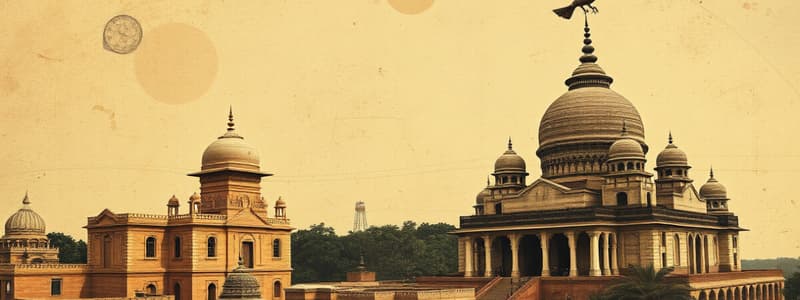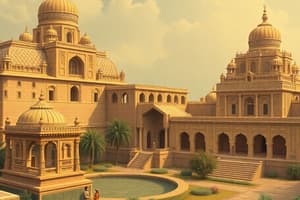Podcast
Questions and Answers
What main agricultural practice was essential for the survival of Harappan cities?
What main agricultural practice was essential for the survival of Harappan cities?
- Fishing in rivers only
- Hunting game animals
- Importing food from distant lands
- Daily supply of agricultural produce from rural areas (correct)
Which crops were notably grown by the Harappans?
Which crops were notably grown by the Harappans?
- Only fruits and vegetables
- Only cereals like corn
- Cereals, pulses, and cotton (correct)
- Exclusively sugarcane and palm trees
What tool did the Harappans create that is still in use by modern farmers?
What tool did the Harappans create that is still in use by modern farmers?
- Plough (correct)
- Sickle
- Hoe
- Scythe
What evidence indicates that the Harappans had a diverse diet?
What evidence indicates that the Harappans had a diverse diet?
Which statement best describes the role of rivers in Harappan agriculture?
Which statement best describes the role of rivers in Harappan agriculture?
Which animals were domesticated by the Harappans?
Which animals were domesticated by the Harappans?
What is a notable finding regarding Harappan cooking practices?
What is a notable finding regarding Harappan cooking practices?
What type of archaeological evidence has been found related to Harappan agriculture?
What type of archaeological evidence has been found related to Harappan agriculture?
What materials did the Harappans likely export based on available data?
What materials did the Harappans likely export based on available data?
Which stone was favored for making ornaments by Harappan craftspeople?
Which stone was favored for making ornaments by Harappan craftspeople?
What was likely imported by the Harappans in exchange for their export goods?
What was likely imported by the Harappans in exchange for their export goods?
Which technique did Harappan craftspeople develop when working with carnelian?
Which technique did Harappan craftspeople develop when working with carnelian?
What was the result of adding tin to copper as practiced by the Harappans?
What was the result of adding tin to copper as practiced by the Harappans?
Which of the following items was NOT mentioned as likely exported by the Harappans?
Which of the following items was NOT mentioned as likely exported by the Harappans?
What is a possible reason the Harappans engaged in trade with other civilizations?
What is a possible reason the Harappans engaged in trade with other civilizations?
What type of materials did the Harappans create using sophisticated techniques?
What type of materials did the Harappans create using sophisticated techniques?
Which city was the first of the Indus-Sarasvatī civilization to be excavated?
Which city was the first of the Indus-Sarasvatī civilization to be excavated?
What is the term used to describe the early development of urban centers in India?
What is the term used to describe the early development of urban centers in India?
Which modern state corresponds to the ancient city of Mohenjo-daro?
Which modern state corresponds to the ancient city of Mohenjo-daro?
What natural features helped shape the boundaries of the settlements of the Indus civilization?
What natural features helped shape the boundaries of the settlements of the Indus civilization?
Which city is located in modern-day Punjab?
Which city is located in modern-day Punjab?
What was significant about the excavation of Harappa in the 1920s?
What was significant about the excavation of Harappa in the 1920s?
Which tributary river is most significant to the settlements of the Indus-Sarasvatī civilization?
Which tributary river is most significant to the settlements of the Indus-Sarasvatī civilization?
Which of the following ancient cities is incorrectly matched with its modern state?
Which of the following ancient cities is incorrectly matched with its modern state?
What was a significant feature of the reservoirs built at Dholavira?
What was a significant feature of the reservoirs built at Dholavira?
What was the purpose of the underground drains connected to the reservoirs at Dholavira?
What was the purpose of the underground drains connected to the reservoirs at Dholavira?
How long was the large reservoir mentioned in the content?
How long was the large reservoir mentioned in the content?
What aspect of the construction of reservoirs might imply about local authority in Dholavira?
What aspect of the construction of reservoirs might imply about local authority in Dholavira?
What challenge did the reservoirs present regarding maintenance?
What challenge did the reservoirs present regarding maintenance?
What can be inferred about the labor force used for constructing the reservoirs?
What can be inferred about the labor force used for constructing the reservoirs?
Why might there have been a need for a local authority to manage the reservoirs?
Why might there have been a need for a local authority to manage the reservoirs?
Where did the Harappans typically establish their settlements?
Where did the Harappans typically establish their settlements?
What feature of Harappan urban planning indicates their emphasis on water management?
What feature of Harappan urban planning indicates their emphasis on water management?
In Mohenjo-daro, how did residents typically obtain water?
In Mohenjo-daro, how did residents typically obtain water?
What was a key feature of the drainage system in Harappan cities?
What was a key feature of the drainage system in Harappan cities?
What was the measurement of the largest reservoir in Dholavira?
What was the measurement of the largest reservoir in Dholavira?
Why is it significant that Harappan cities had no inscriptions or written accounts available?
Why is it significant that Harappan cities had no inscriptions or written accounts available?
Which of the following materials were commonly used for wells in Mohenjo-daro?
Which of the following materials were commonly used for wells in Mohenjo-daro?
What is one reason why separate bathing areas were significant in Harappan homes?
What is one reason why separate bathing areas were significant in Harappan homes?
What does the existence of individual bathrooms suggest about the Harappan civilization?
What does the existence of individual bathrooms suggest about the Harappan civilization?
Flashcards are hidden until you start studying
Study Notes
Water Management in Harappan Civilisation
- Harappans prioritized cleanliness and water management with homes featuring individual bathrooms.
- Large drainage systems under streets efficiently carried waste water away.
- Mohenjo-daro utilized numerous brick wells for water supply, while other regions relied on ponds and streams.
Reservoirs and Water Storage
- Dholavira housed the largest known reservoir, measuring 73 meters in length, with at least six large reservoirs made of stone.
- Reservoirs were connected by underground drains for optimal water distribution.
- The construction and maintenance of these systems suggest organized labor and possible local authorities overseeing municipal tasks.
Agriculture and Diet
- Settlements flourished near rivers for irrigation and agriculture, leading to diverse crop cultivation.
- Harappans grew cereals such as barley and wheat, millets, rice, and pulses; they were pioneers in cotton cultivation.
- Evidence shows varied diet, including animal and fish consumption, with cooking pots containing remains of dairy products, turmeric, ginger, and banana.
Trade and Craftsmanship
- Harappans engaged in extensive trade with neighboring civilizations, exporting goods like ornaments, timber, gold, and cotton.
- Carnelian beads, a semiprecious stone from Gujarat, were popular exports, creatively drilled and decorated by craftspeople.
- Copper was likely an imported item, as it was scarce in the Harappan region, contributing to the development of bronze for tools and decorative items.
Urbanization and Settlements
- The Indus-Sarasvatī civilisation featured major cities such as Dholavira, Harappa, Kalibangan, Mohenjo-daro, and Rakhigarhi.
- The civilization represents India's first urbanization phase, leveraging the geographical advantages of river systems.
- Knowledge of each city's location corresponds to modern states, such as Harappa in Punjab and Mohenjo-daro in Haryana.
Cultural Artifacts and Society
- Archaeological findings reveal sophisticated cooking utensils and tools, indicating advanced domestic and agricultural practices.
- The scale of labor required for infrastructure hints at a structured society capable of organizing and sustaining large projects.
- The absence of written records has led to various interpretations and continued exploration into the social structure and governance of the Harappan civilization.
Studying That Suits You
Use AI to generate personalized quizzes and flashcards to suit your learning preferences.




